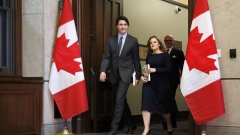Apr 9, 2022
Nations Eye Modern Arms for Ukraine as Soviet-Era Stocks Dwindle
, Bloomberg News
(Bloomberg) -- Some supporters of Ukraine are ready to start helping it shift from Soviet-era weapons to more modern NATO-style equipment in the conflict with Russia, given the prospect the war drags on for months or even years.
Countries have largely held back on supplying state-of-the-art weaponry to avoid having to train Ukrainian forces to use it.
But NATO’s eastern states risk running out of Soviet-produced equipment at some point. Slovakia is giving a Russian-made S-300 air-defense system to Ukraine, although in turn it will now receive a Patriot missile defense system from America.
Some allies may start training Ukrainian troops outside the country to be able to maintain and use more sophisticated weapons, according to people familiar with discussions between Group of Seven and NATO members. The aim would be to help Ukraine gradually transition toward NATO-type standards, one of the people said.
In the meantime, NATO countries are rushing other weapons to Ukraine to help it defend territory in the east from a redirected Russian assault.
Foreign Minister Dmytro Kuleba, who met with NATO in Brussels during the week, praised nations for providing more weaponry but lamented that it was taking too long for nations to adjust their thinking on what to send Ukraine as the war progressed. Kyiv has said its needs include anti-aircraft missile systems, armored vehicles and tanks.
Kuleba spoke of a request he made for “a certain a state-of-the-art weapon” from a counterpart from another country in the first week of war that was rejected over the need to train forces for at least two months.
“If he had agreed with me in the very beginning to provide Ukraine with that weapon, our people would be about to complete this training and we would have had it in a week or two,” Kuleba told reporters following the meetings. He didn’t identify the weapon or country involved.
Read more: Race On to Rearm Eastern Front That May Decide Ukraine War
In the NATO meetings, Kuleba also stressed it was important for partners to start taking a longer-term view and sending more modern systems, along with making a plan for training and maintenance, according to the people familiar with the matter.
U.K. Foreign Secretary Liz Truss told reporters there was support among allies to supply new and heavier equipment. “We’ve agreed to help Ukrainian forces move from their Soviet era equipment to NATO standard equipment on a bilateral basis,” she said. NATO Secretary General Jens Stoltenberg also said allies were sending both Soviet and more modern weapons.
Following the meetings, Stoltenberg warned the war could possibly last for months and even years. General Mark Milley, chairman of the Joint Chiefs of Staff, said it was “going to be a long slog.”
NATO officials have pointed to past training support for Ukraine’s military as one reason its forces have managed to resist Russian advances.
But that kind of help is also likely to draw attention from Moscow. Last month, Russian missiles hit a military center near Lviv in western Ukraine close to Poland, where the U.S. and others previously trained Ukrainian forces.
China, which has declined to condemn Russia’s invasion and has criticized NATO’s security posture, also chided France for arming Ukraine. “One should not call for ceasefire & end of hostilities while shipping large quantities of advanced weapons and equipment to escalate the conflict,” Foreign Ministry spokeswoman Hua Chunying posted on Twitter on Friday.
The U.S. has already trained a small number of Ukrainian troops since the start of the war, according to Pentagon spokesman John Kirby. He said the soldiers, who were already in the U.S., were given a few days of training on Switchblade armed drones, 100 of which have already been sent to Ukraine.
Still, the new weapons that allies plan to send may not immediately help fend off a major new offensive by Russia in the eastern Donbas region.
Kuleba said Ukraine needed more assistance “in a matter of days, not weeks” and, given the training required, it will still be dependent on the supplies of Soviet equipment it can get sooner.
©2022 Bloomberg L.P.








